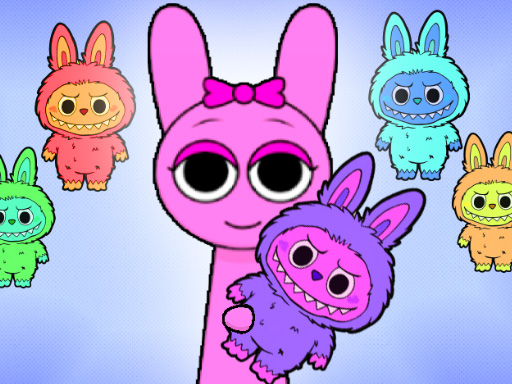Draw The Line
About Draw The Line
Okay, so you know how sometimes you stumble across a game, almost by accident, and it just… clicks? Like, it’s not the one you were actively searching for, it doesn’t have the flashy marketing budget of a AAA title, but it just gets its hooks into you in the best possible way? That’s exactly what happened to me with this absolute gem called Draw The Line. Honestly, I’m still buzzing from some of the levels I’ve cleared, and I just *had* to tell you about it because I think you’re going to absolutely adore it.
I mean, at first glance, you might think, "Oh, another one of those simple mobile games." And yeah, it is simple in its core mechanic, but that's where the genius lies, you know? It's like those games that look deceptively easy until you actually dive in and realize there's a whole universe of cleverness packed into such a straightforward concept. What I love about games like this is how they strip away all the unnecessary fluff and just focus on pure, unadulterated gameplay. There's something magical about that kind of elegant design, where every element serves a purpose and nothing feels extraneous.
When I first fired it up, I was just looking for something to unwind with after a particularly brutal day. My brain felt like a tangled ball of yarn, and I just needed something to untangle it, something that wouldn't demand too much, but still offered a sense of accomplishment. And that's exactly what the initial stages of Draw The Line deliver. You're presented with these beautiful, often abstract, patterns or shapes, and your goal is simple: connect all the dots, or trace all the lines, with a single, continuous stroke. No lifting your finger, no retracing. It sounds almost meditative, right? And it totally is. You can almost feel the tension draining from your shoulders as you swipe your finger across the screen, watching a vibrant line bloom in your wake, perfectly filling the designated path. It’s incredibly satisfying, like a digital zen garden. The colors are usually soft and inviting, the sound effects are subtle and pleasing – just a gentle chime when you complete a level, a soft whoosh as your line extends. It creates this really lovely, almost hypnotic rhythm. I’ve always been drawn to games that manage to combine simplicity with an artistic touch, and this one absolutely nails it. It’s not just a game; it’s an experience in mindful creation, a moment of calm in a chaotic world.
But here’s the brilliant thing about this game, and where it truly transcends being just a "relaxing" experience: it's got this incredible duality. Just when you're lulled into this wonderful sense of calm, perfectly tracing elegant curves and simple grids, it subtly, almost imperceptibly, starts to introduce these little brain-tickling challenges. It's like the game winks at you and says, "Oh, you thought that was easy? Let's see how you handle *this*." And suddenly, those simple grids become intricate labyrinths. The dots aren't just points to connect; they're strategic markers. The paths aren't just lines to trace; they're puzzles waiting to be unraveled.
You'll find yourself staring at a screen, a seemingly impossible tangle of nodes and potential routes, and your mind just starts to hum. "Okay, if I go this way first, I'll block myself off from that section. But if I start *there*, how do I get back to cover these other two?" The brilliant thing about this is that it never feels unfair. Every puzzle has a solution, and that's what keeps you hooked. The frustration isn't the kind that makes you want to throw your phone across the room; it's the good kind, the kind that sharpens your focus and makes the eventual breakthrough all the sweeter. You know that feeling when you're stuck on a puzzle, and you've tried three different approaches, and none of them quite work, and then suddenly, *boom*, it clicks? Like a light bulb goes off in your head, and you see the entire path laid out before you, clear as day? That's the sensation I get with Draw The Line, time and time again.
The real magic happens when you encounter levels that introduce new mechanics without even telling you. Like, you'll be tracing along, feeling confident, and then you hit a section that seems to defy the rules. Maybe there's a barrier that only disappears after you've crossed a certain point, or a switch that changes the state of another part of the grid. The game doesn't give you a tutorial pop-up; it just lets you discover it through experimentation. You'll try a path, fail, try another, fail, and then on the third or fourth attempt, you'll notice a subtle visual cue you missed before, or a pattern in the way the environment reacts. And that moment of realization, that "Aha! That's how it works!" is just pure gaming gold. It makes you feel incredibly clever, like you've outsmarted the game itself.
In my experience, the best moments come when you're deep into one of these more complex puzzle levels, and you've been working on it for a few minutes, maybe even longer, and you're just about to give up. You take a deep breath, clear your mind, and try one last, desperate sequence of moves. You start drawing, your finger gliding across the screen, holding your breath, almost willing the line to go where it needs to go, anticipating each turn, each connection. And then, as you complete the very last segment, a little celebratory animation plays, and that satisfying chime rings out. It's not just a sound; it's a feeling of profound accomplishment. You can almost feel the tension in your shoulders release as you lean back in your chair, a triumphant grin spreading across your face. It's that kind of visceral satisfaction that keeps me coming back.
What's fascinating is how the game manages to scale its difficulty so smoothly. You never feel like you're suddenly hit with an impossible wall. Instead, it gently ramps up, introducing new complexities one by one, building on what you've already learned. It’s a masterclass in progressive design. One minute you're connecting a simple square, the next you're navigating a multi-layered structure with teleporters and conditional gates, all while still adhering to that core "one line" rule. It makes me wonder how many clever variations they can come up with for such a seemingly simple premise.
Honestly, I've lost track of time so many times playing this. I'll pick it up for "just five minutes" to clear a couple of levels, and before I know it, half an hour has vanished. It's got that perfect blend of instant gratification and long-term engagement. Whether you need a quick mental break or a deep dive into some serious puzzle-solving, Draw The Line has something for you. It’s the kind of game that reminds you why you love gaming in the first place – the challenge, the discovery, the pure joy of solving a problem, all wrapped up in a beautifully minimalist package. You've really got to try it. I promise, you won't regret it.
I mean, at first glance, you might think, "Oh, another one of those simple mobile games." And yeah, it is simple in its core mechanic, but that's where the genius lies, you know? It's like those games that look deceptively easy until you actually dive in and realize there's a whole universe of cleverness packed into such a straightforward concept. What I love about games like this is how they strip away all the unnecessary fluff and just focus on pure, unadulterated gameplay. There's something magical about that kind of elegant design, where every element serves a purpose and nothing feels extraneous.
When I first fired it up, I was just looking for something to unwind with after a particularly brutal day. My brain felt like a tangled ball of yarn, and I just needed something to untangle it, something that wouldn't demand too much, but still offered a sense of accomplishment. And that's exactly what the initial stages of Draw The Line deliver. You're presented with these beautiful, often abstract, patterns or shapes, and your goal is simple: connect all the dots, or trace all the lines, with a single, continuous stroke. No lifting your finger, no retracing. It sounds almost meditative, right? And it totally is. You can almost feel the tension draining from your shoulders as you swipe your finger across the screen, watching a vibrant line bloom in your wake, perfectly filling the designated path. It’s incredibly satisfying, like a digital zen garden. The colors are usually soft and inviting, the sound effects are subtle and pleasing – just a gentle chime when you complete a level, a soft whoosh as your line extends. It creates this really lovely, almost hypnotic rhythm. I’ve always been drawn to games that manage to combine simplicity with an artistic touch, and this one absolutely nails it. It’s not just a game; it’s an experience in mindful creation, a moment of calm in a chaotic world.
But here’s the brilliant thing about this game, and where it truly transcends being just a "relaxing" experience: it's got this incredible duality. Just when you're lulled into this wonderful sense of calm, perfectly tracing elegant curves and simple grids, it subtly, almost imperceptibly, starts to introduce these little brain-tickling challenges. It's like the game winks at you and says, "Oh, you thought that was easy? Let's see how you handle *this*." And suddenly, those simple grids become intricate labyrinths. The dots aren't just points to connect; they're strategic markers. The paths aren't just lines to trace; they're puzzles waiting to be unraveled.
You'll find yourself staring at a screen, a seemingly impossible tangle of nodes and potential routes, and your mind just starts to hum. "Okay, if I go this way first, I'll block myself off from that section. But if I start *there*, how do I get back to cover these other two?" The brilliant thing about this is that it never feels unfair. Every puzzle has a solution, and that's what keeps you hooked. The frustration isn't the kind that makes you want to throw your phone across the room; it's the good kind, the kind that sharpens your focus and makes the eventual breakthrough all the sweeter. You know that feeling when you're stuck on a puzzle, and you've tried three different approaches, and none of them quite work, and then suddenly, *boom*, it clicks? Like a light bulb goes off in your head, and you see the entire path laid out before you, clear as day? That's the sensation I get with Draw The Line, time and time again.
The real magic happens when you encounter levels that introduce new mechanics without even telling you. Like, you'll be tracing along, feeling confident, and then you hit a section that seems to defy the rules. Maybe there's a barrier that only disappears after you've crossed a certain point, or a switch that changes the state of another part of the grid. The game doesn't give you a tutorial pop-up; it just lets you discover it through experimentation. You'll try a path, fail, try another, fail, and then on the third or fourth attempt, you'll notice a subtle visual cue you missed before, or a pattern in the way the environment reacts. And that moment of realization, that "Aha! That's how it works!" is just pure gaming gold. It makes you feel incredibly clever, like you've outsmarted the game itself.
In my experience, the best moments come when you're deep into one of these more complex puzzle levels, and you've been working on it for a few minutes, maybe even longer, and you're just about to give up. You take a deep breath, clear your mind, and try one last, desperate sequence of moves. You start drawing, your finger gliding across the screen, holding your breath, almost willing the line to go where it needs to go, anticipating each turn, each connection. And then, as you complete the very last segment, a little celebratory animation plays, and that satisfying chime rings out. It's not just a sound; it's a feeling of profound accomplishment. You can almost feel the tension in your shoulders release as you lean back in your chair, a triumphant grin spreading across your face. It's that kind of visceral satisfaction that keeps me coming back.
What's fascinating is how the game manages to scale its difficulty so smoothly. You never feel like you're suddenly hit with an impossible wall. Instead, it gently ramps up, introducing new complexities one by one, building on what you've already learned. It’s a masterclass in progressive design. One minute you're connecting a simple square, the next you're navigating a multi-layered structure with teleporters and conditional gates, all while still adhering to that core "one line" rule. It makes me wonder how many clever variations they can come up with for such a seemingly simple premise.
Honestly, I've lost track of time so many times playing this. I'll pick it up for "just five minutes" to clear a couple of levels, and before I know it, half an hour has vanished. It's got that perfect blend of instant gratification and long-term engagement. Whether you need a quick mental break or a deep dive into some serious puzzle-solving, Draw The Line has something for you. It’s the kind of game that reminds you why you love gaming in the first place – the challenge, the discovery, the pure joy of solving a problem, all wrapped up in a beautifully minimalist package. You've really got to try it. I promise, you won't regret it.
Enjoy playing Draw The Line online for free on Viralexclusivo Games. This Arcade game offers amazing gameplay and stunning graphics. No downloads required, play directly in your browser!
How to Play
Through the easy one line drawing gameplay you can relax your stress and experience a relaxing and enjoyable game time





Comments
This game is awesome! I love the graphics and gameplay.
One of the best games I've played recently. Highly recommended!